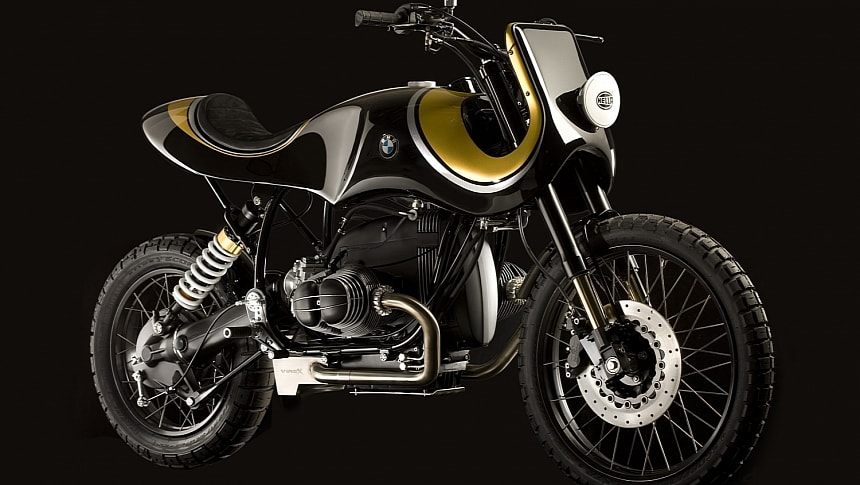Gianluca and his team at Stile Italiano are no strangers to pushing boundaries or experimenting with fresh ideas, so their custom bikes have no problem standing out from the crowd. The workshop’s take on the GS platform from BMW is no different, and the extent to which this specimen has been modified is pretty astounding to say the least! Without further ado, let’s dive in for a closer look.
Stile kicked things off with a 1991 variant of Motorrad’s R 100 GS lineup, promptly deleting all its stock bodywork along with many other bits and pieces. Then, the guys fashioned a new subframe that would suit the geometry they were going for, while also revising the mounting points for the rear suspension. As a very neat little touch, the subframe tube down on the right splits up to let the monoshock pass through.
The rear suspension hardware itself is a premium STX unit from Ohlins, the same brand you will find at the front end. More specifically, we’re referring to a beefy pair of FG 424 inverted forks that measure 43 mm (1.7 inches) in diameter. Fresh triple clamps hold these new suspension goodies in place, with the bottom one being a repurposed Triumph item while its upper counterpart is a bespoke module built from scratch.
Down in the unsprung sector, the R 100 GS received aftermarket rims measuring 21 inches at the front and 17 inches out back. For ample grip on dirt and asphalt alike, these new hoops are embraced by dual-purpose Scorpion Rally knobbies fore and aft. With the chassis-related work out of the way, Stile Italiano wasted no time getting started on the bodywork.
They came up with a gorgeous monocoque structure that merges the tail, fuel tank, and front fairing into a single unit. Its curvy contours flow seamlessly from front to back, complemented by a handmade solo seat upholstered in standard black leather on the sides and suede up top. A circular LED taillight adorns the rearmost tip of the bodywork, but then there is that Hella headlight protruding from the fairing at the front.
In the cockpit, you will now see an aftermarket handlebar perched on billet aluminum risers, fronting a Motogadget ChronoClassic dial located atop the gas tank. The handlebar comes equipped with Domino grips, a Brembo front brake master cylinder, and minimalistic switches, but there are no mirrors to speak of. CNC-machined Tarozzi rearsets round out the creature’s ergonomics.
Of course, Stile Italiano hasn’t overlooked the Beemer’s boxer-twin, treating it to an invigorating refurbishment and installing 40 mm (1.6-inch) Mikuni carbs in the process. The inhalers are capped off with short, mesh-covered velocity stacks for optimal airflow, and a modern electronic ignition ensures a potent spark. A Virex exhaust system is now located at the other end of the combustion cycle.
The rear suspension hardware itself is a premium STX unit from Ohlins, the same brand you will find at the front end. More specifically, we’re referring to a beefy pair of FG 424 inverted forks that measure 43 mm (1.7 inches) in diameter. Fresh triple clamps hold these new suspension goodies in place, with the bottom one being a repurposed Triumph item while its upper counterpart is a bespoke module built from scratch.
Down in the unsprung sector, the R 100 GS received aftermarket rims measuring 21 inches at the front and 17 inches out back. For ample grip on dirt and asphalt alike, these new hoops are embraced by dual-purpose Scorpion Rally knobbies fore and aft. With the chassis-related work out of the way, Stile Italiano wasted no time getting started on the bodywork.
They came up with a gorgeous monocoque structure that merges the tail, fuel tank, and front fairing into a single unit. Its curvy contours flow seamlessly from front to back, complemented by a handmade solo seat upholstered in standard black leather on the sides and suede up top. A circular LED taillight adorns the rearmost tip of the bodywork, but then there is that Hella headlight protruding from the fairing at the front.
In the cockpit, you will now see an aftermarket handlebar perched on billet aluminum risers, fronting a Motogadget ChronoClassic dial located atop the gas tank. The handlebar comes equipped with Domino grips, a Brembo front brake master cylinder, and minimalistic switches, but there are no mirrors to speak of. CNC-machined Tarozzi rearsets round out the creature’s ergonomics.
Of course, Stile Italiano hasn’t overlooked the Beemer’s boxer-twin, treating it to an invigorating refurbishment and installing 40 mm (1.6-inch) Mikuni carbs in the process. The inhalers are capped off with short, mesh-covered velocity stacks for optimal airflow, and a modern electronic ignition ensures a potent spark. A Virex exhaust system is now located at the other end of the combustion cycle.

